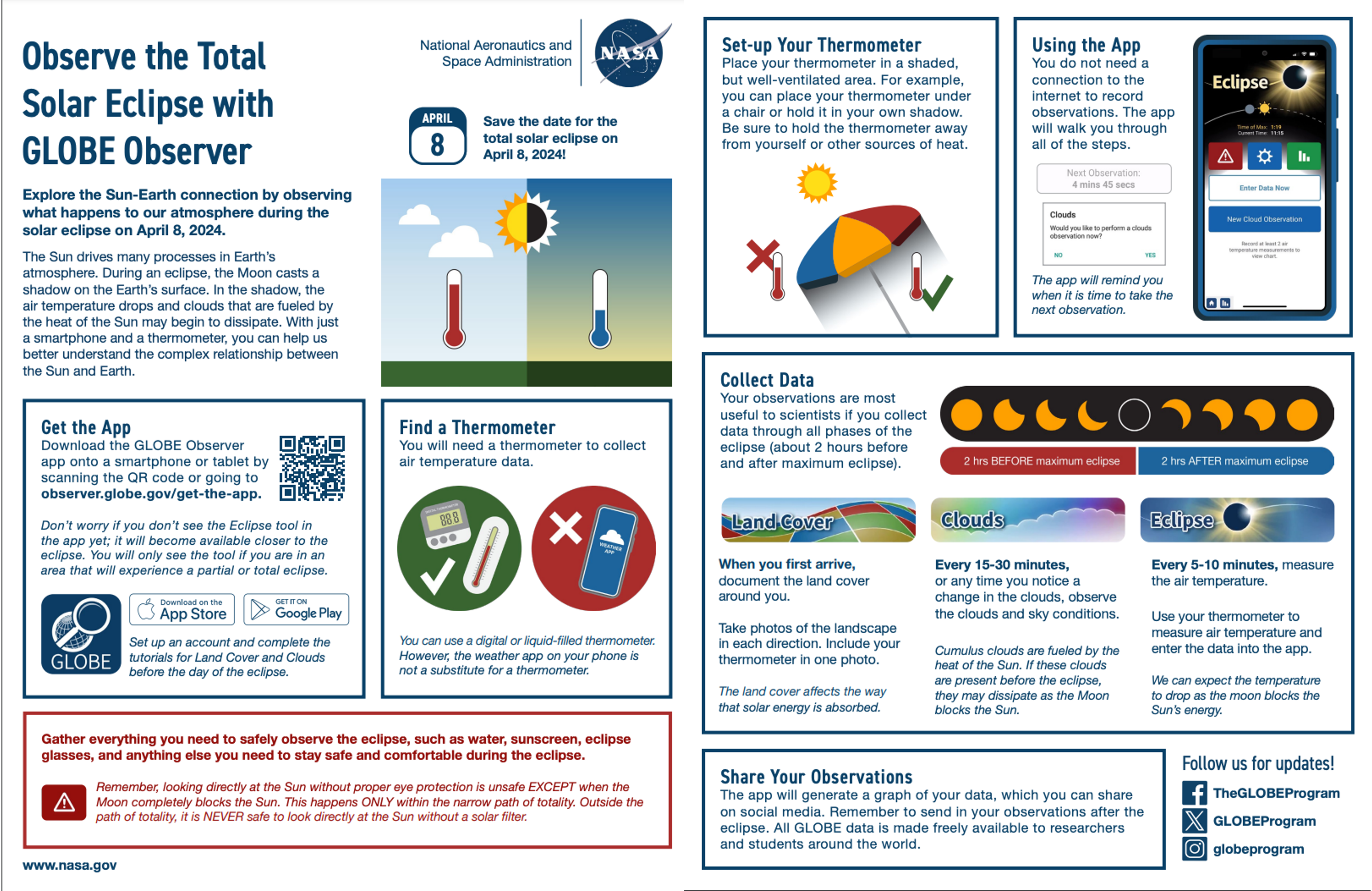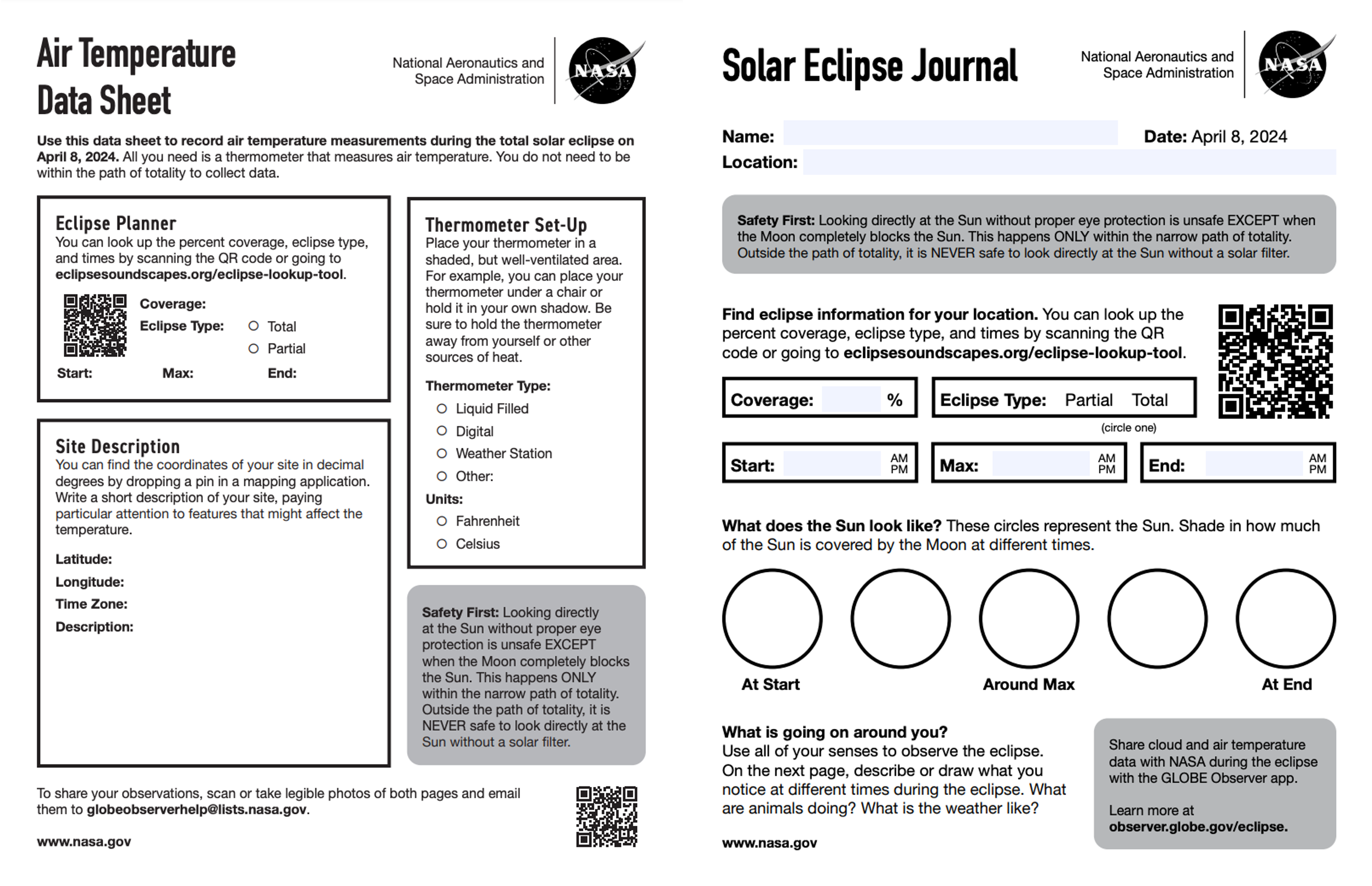News - GLOBE Observer
Supporting GLOBE Student Investigations of the Eclipse

The upcoming 8 April total solar eclipse provides a rich
opportunity for student learning. GLOBE educator and NASA Langley
Research Center scientist Jessica Taylor offered the following tips
in a blog
originally published on the GLOBE website.
On April 8, 2024 many of us in North America will have the opportunity to experience a solar eclipse. Whether you’re in the path of totality, or will be experiencing a partial eclipse, it’s sure to be all the buzz. This is a great opportunity to turn the excitement about the solar eclipse into curiosity about other fields of science.
During the eclipse, as the moon comes between us and the Sun, we will experience a sudden change in the amount of Sun’s energy reaching our surface. This can cause changes in our atmosphere including changes in air temperature, surface temperature, clouds, and wind. This can make for interesting GLOBE student research!
In fact, GLOBE is interested in learning more about clouds and their relation to Sun’s heating with the upcoming GLOBE Eclipse Challenge: Clouds and Our Solar-Powered Earth running from March 15- April 15. As the Sun rises and sets, it warms the Earth’s surface at different intensities. These changes in heat lead to changes in the clouds, especially the types of clouds. To study these changes, we need observations at different times over the course of hours, days, weeks, months, and years from around the globe. One instance of rapid change is the upcoming total solar eclipse on 8 April. This natural experiment is a great opportunity for those experiencing the eclipse to study how rapidly changing solar energy influences clouds and temperature.

Solar energy fuels many processes on Earth, including cloud formation, winds and temperature. This image is available as a poster.
GLOBE Observer, the app of The GLOBE Program, will release a special GLOBE Eclipse Tool just before the eclipse. On the day of the eclipse, April 8th, when you go into the Eclipse Tool, you will see when maximum coverage will be for your location. The app will remind you to make observations of clouds and air temperature before and after the eclipse, at about 10-minute intervals. You can also document your location by making a land cover observation in the Eclipse tool. Be sure when using an air temperature thermometer to first calibrate the thermometer and minimize other factors that can influence your temperature reading, such as measuring temperature in the shade. The GLOBE Eclipse Overview sheet summarizes how to participate in data collections using the GLOBE Eclipse tool.

GLOBE has provided many resources to support eclipse data
collection, including this overview
sheet, a training
video, and a foldable
guide to using the GLOBE Observer Eclipse tool. All resources
are available in English and Spanish.
Educators have shared experiences from recent eclipses and suggest that in addition to having the option to enter GLOBE data directly in the app, to also use paper data sheets. This can also help if you are trying to engage multiple learners but do not have a device for each. The Eclipse Air Temperature Data Sheets (in English and Spanish) can help keep your data organized.
After you collect and submit your data, you’ll want to help learners analyze the data and put their research project together. If you used the Eclipse Tool to collect data, you already have access to a graph of your data. If not, the Atmosphere Changes During Eclipse Spreadsheet can help you organize and analyze your data. You can then use the Eclipse Student Research Poster Template to help put all the main pieces of a student research project together in poster format. Finally, consider sharing the research by uploading their GLOBE Student Research Report.

A paper
data sheet (left) may be the simplest way for groups of
students to record their observations of air temperature during the
eclipse. The Solar
Eclipse Journal (right) is a good way for students to record
qualitative observations and reflections.
If you’re looking for a less quantitative way to document your eclipse experience, check out the Solar Eclipse Journal. This sheet encourages you to use all your senses in experiencing the eclipse and even provides sentence starters to help you reflect upon changes during the solar eclipse.
No matter what you choose, make sure you and those around you practice proper eclipse viewing safety. I hope you enjoy your eclipse experience.
Comments
View more GLOBE Observer news here.








